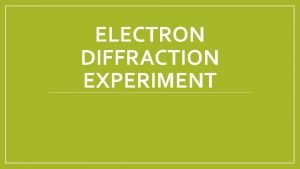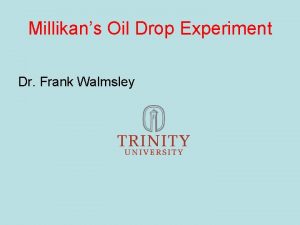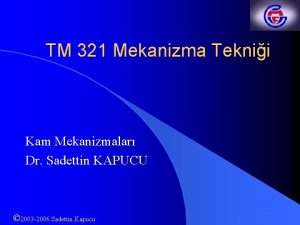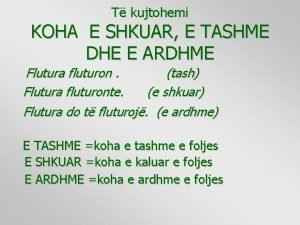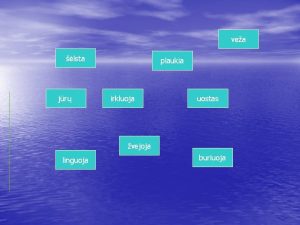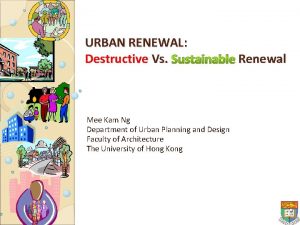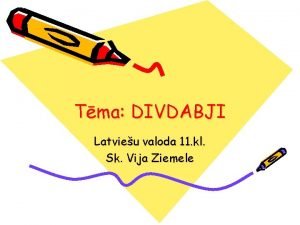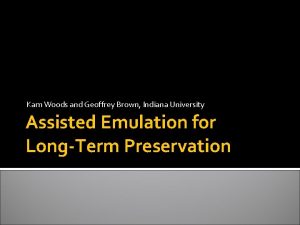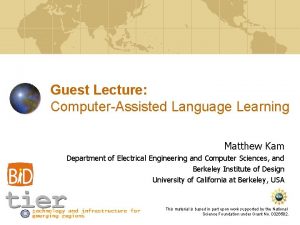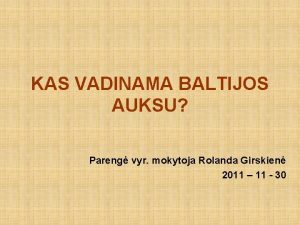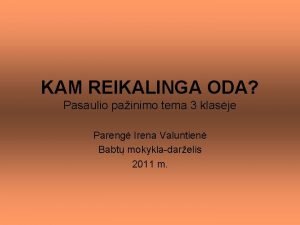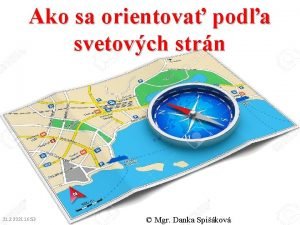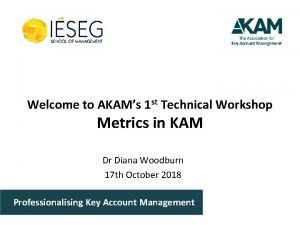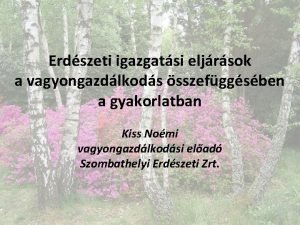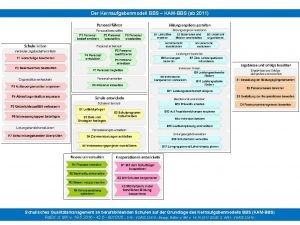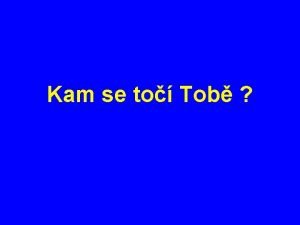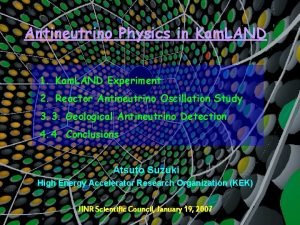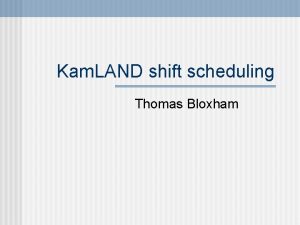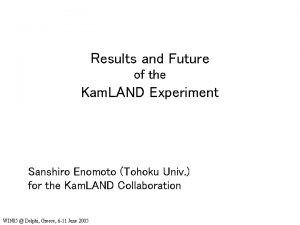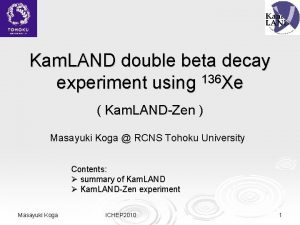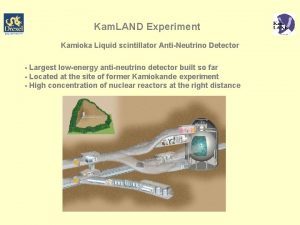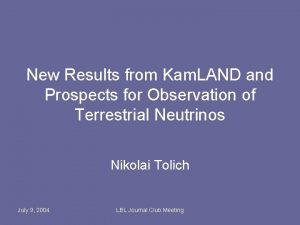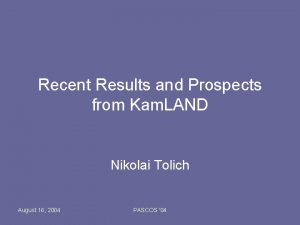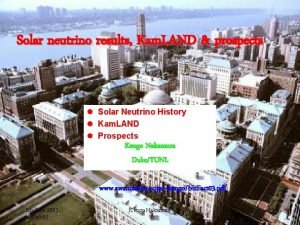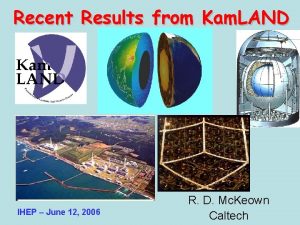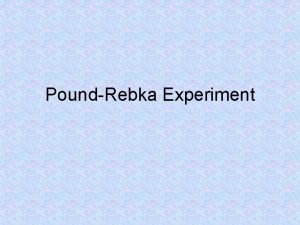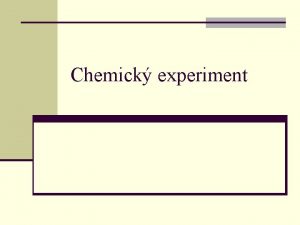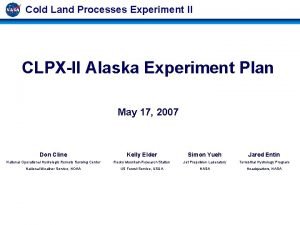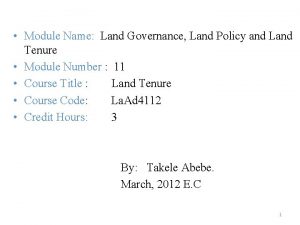Results and plans of the Kam LAND experiment
























![Signal (U+Th) [TNU] Signal v. s. heat 99% C. L. upper limit from Kam. Signal (U+Th) [TNU] Signal v. s. heat 99% C. L. upper limit from Kam.](https://slidetodoc.com/presentation_image/44f5ee67704e129264f319fe9d8391a6/image-25.jpg)













































- Slides: 70

Results and plans of the Kam. LAND experiment Yoshihito Gando (RCνS, Tohoku Univ. ) for the Kam. LAND Collaboration ICFP 2005 @ Chung-li, Taiwan, 4 October 2005

Various Physics Targets with wide energy range 0. 4 1. 0 2. 6 neutrino electron elastic scattering 7 Be solar neutrino geo-neutrino 8. 5 Visible energy [Me. V] inverse beta decay reactor neutrino supernova relic neutrino etc. Neutrino Astrophysics Neutrino Geophysics Neutrino Physics Neutrino Cosmology verification of SSM verification of earth evolution model Precision measurement of oscillation parameters verification of universe evolution future 2 nd phase Nature 436, 28 (2005) 1 st results Solar PRL 90, 021802 (2003) PRL 92, 071301 (2004) 2 nd results PRL 94, 081801(2005)

Kam. LAND detector 1000 m Cosmic ray 's are suppressed by 1/100, 000. 20 inch : 225 1. 75 m thickness 13 m 17 inch : 1325 20 inch : 554 Photo - coverage: 34% ~ 500 p. e. / Me. V 1, 000 ton liquid scintillator Dodecane : 80% Pseudocumene : 20% PPO : 1. 5 g/l ~8000 photons / Me. V λ: ~10 m Mineral oil Dodecane : 50% Isoparaffin : 50%

νe detection in Kam. LAND e + p e e+ + n p E 1. 8 Me. V (0. 51) Te+ e+ e Prompt e+ signal Te++annihilation =Eν - 0. 8 Me. V (0. 51) n ~210μs • Position • Time correlation • delayed energy information p d (2. 2 Me. V) Delayed γ by neutron capture Greatly removes backgrounds

Reactor Neutrino

Reactors near the Kam. LAND 80% of total contribution comes from 130~220 km distance effective distance ~180 km Reactor neutrino flux, ~95. 5% from Japan (2 nd result period) ~3% from Korea Reactors in Taiwan have ~0. 1% contribution.

Event Selection Delayed Coincidence: Prompt Energy Window: 2. 6 < Eprompt < 8. 5 Me. V 0. 5 < ΔT < 1000μsec ΔR < 200 cm 1. 8 < Edelayed < 2. 6 Me. V Fiducial Volume: Rprompt < 550 cm (500 : 1 st result) Rdelayed < 550 cm (500 : 1 st result) μ 3 m 9 Li Spallation Cuts: ΔTμ < 2 msec ΔTμ < 2 sec (showering muons) or ΔTμ < 2 sec (showering muons) ΔL < 300 cm (non-showering) Isotope Halflives Decay Mode 9 Li/8 He 178. 3 ms/119. 0 msβ- + n Efficiency : 89. 82%(I, II), 89. 83%(III)

Time Variation of Reactor ν Expected event rate Observed event rate First result Expected signal : 86. 8± 5. 6 BG : 1± 1 Observed : 54 Neutrino disappearance at 99. 95% • R = 0. 658 ± 0. 044(stat) ± 0. 042(syst) ⇒ neutrino disappearance at 99. 998% C. L. High statistic from 1 st result oscillation study

Energy Spectrum • Hypothesis test of scaled no-oscillation: χ2/ndf = 37. 3/18 ⇒ spectral distortion at > 99. 6% C. L. • Rate + Shape: no oscillation is excluded at 99. 999995% C. L.

L/E plot with data for geo-ν analysis (759 days, 5 m fiducial) low energy window best fit reactor + geo-neutrino model prediction Oscillation pattern with real reactor distribution Lo = 180 km is used for Kam. LAND There is clear Oscillatory behavior (peak and dip) oscillation parameter is determined.

Oscillation Analysis Kam. LAND best-fit (rate + shape) Kam. LAND + Solar assuming CPT invariance several orders -> less than 10% Precise determination of oscillation parameters made possible to use neutrinos as a new probe.

Geo - Neutrino

Earth Energetics • Terrible earthquakes, eruptions, etc. are originally caused by mantle convection driven by heat. • Terrestrial magnetism is caused by a core movement, it requires some heat source. • Observed Surface Heat Flow : ~ 44 TW (31 TW : re-evaluation) • Radiogenic Heart : ~20 TW ? U-chain 8 TW / Th-chain 8 TW / 40 K 3 TW? ? ? (BSE model) • Radioactive heat sources contribute to about the half of the total heat outflow of the earth. • Geo-Neutrino is Produced by β-decay of radioactive element in the earth

Methods of research about inside of the earth Seismic analysis Meteorite analysis Composition of the earth (Proto material ) is presumed by meteorite analysis BSE (bulk silicate Earth) model Mc. Donough et al. (1995) • Physical parameter (density, elastic parameter etc…) • It does not tell chemical composition • Th/U mass ratio ~ 3. 9 • It expect that 20 TW comes from radioactivity • There are no direct measurements Direct measurement is desired!!

Geophysics with Neutrino • Determination of the amount and distribution of U, Th in the earth from geo-ν observation - Test for BSE model Verification of basic paradigm of geochemical earth formation and generation - Determination of heat balance Information for earth dynamics, evolution, terrestrial magnetism - Understanding of chemical composition of deep interior of the earth Determination of chemical structure model (mantle model)

Reference Earth Model Upper continental crust U : 2. 8 ppm / Th: 10. 7 ppm Middle continental crust U : 1. 6 ppm / Th: 6. 1 ppm Rudnick et. al. (1995) Lower continental crust U : 0. 2 ppm / Th: 1. 2 ppm continental crust Oceanic crust U: 0. 08 ppm / Th: 0. 32 ppm Th/U ~3. 9 Radiogenic heat ~16 TW U: 0 ppm / Th: 0 ppm mantle Core U: 0. 012 ppm / Th: 0. 048 ppm Ionic radius of U/Th are large Core is very high density do not exist Mantle = Meteorite (BSE model) - Crust

U/Th distribution maps in Japan Average component of upper continental crust Geological map + rock sample (Togashi et al. ) U : 2. 32 ppm Th : 8. 3 ppm Assume the surface U, Th distribution extends to 5 km in depth Geo-neutrino flux is calculated from global and local U, Th composition

Geo-Neutrino spectrum

Event Selection (Geo-ν) Delayed Coincidence: 0. 5 < ΔT < 1000μsec ΔR < 100 cm 0. 9 < Eprompt < 2. 6 Me. V 1. 8 < Edelayed < 2. 6 Me. V Fiducial Volume: Rprompt < 500 cm Rdelayed < 500 cm ρxy > 120 cm Spallation Cuts: ΔTμ < 2 msec, total volume (for all muons) ΔTμ < 2 sec, total volume (showering muons) or ΔTμ < 2 sec, ΔL < 300 cm (Non-showering muons) Efficiency U-Series : 69. 2% , Th-Series : 68. 0%

(α, n) Background αcomes from 210 Po decay (daughter nuclei of 222 Rn) Unfortunately, we inputted 222 Rn at the construction Recent paper shows few % lower cross section of 13 C (α, n) 16 O (Harissopulos et al, nucl-ex/0509014) We could reduce about B. G. uncertainty

Expected spectrum reactor BG + Geo-ν BG total (α, n) reaction Accidental coincidence Reactor ν Th-chain geo-ν U-chain geo-ν

Expected + observed spectra 749. 1 live days Observed 152 B. G. 127. 4± 13. 3 Signal 24. 2± 17. 9

Rate + Shape analysis Th/U Mass ratio=3. 9 90%CL 2 NU+NTh C. L. contours for detected U and Th geo- s. Th/U mass Ratio=3. 9 54. 2 4. 5 (NU NTh)/(NU+NTh) Prediction from the BSE model NU+NTh N U+ N Th : Consistent with prediction of BSE model. We observed 4. 5 - 54. 2 geo-neutrinos with 90%C. L 99% C. L. upper limit : 70. 7 events

Geo-ν after purification Assume 210 Pb : 10 -5 level (α, n) reaction and other radioactive backgrounds are negligible 749 days data • fiducial volume : R < 5 m 5. 5 m • detection efficiency : 90% • error : 54% 28% (statistical error of reactor neutrino is dominant) • Significance : 99. 96% precise measurement
![Signal UTh TNU Signal v s heat 99 C L upper limit from Kam Signal (U+Th) [TNU] Signal v. s. heat 99% C. L. upper limit from Kam.](https://slidetodoc.com/presentation_image/44f5ee67704e129264f319fe9d8391a6/image-25.jpg)
Signal (U+Th) [TNU] Signal v. s. heat 99% C. L. upper limit from Kam. LAND data Fiorentini et al. (hep-ph/0508048) Re-calculation with new cross section for (α, n) reaction for 13 C Relationship line from geochemical and geophysical constraints BSE Fully radiogenic Heat (U+Th) [TW] • Analysis improvement • B. G. reduction • More statistics We will contribute to geology

Future Plan

Next target of Kam. LAND 0. 4 1. 0 2. 6 neutrino electron elastic scattering 7 Be solar neutrino Neutrino Astrophysics geo-neutrino Neutrino Geophysics 8. 5 Visible energy [Me. V] inverse beta decay reactor neutrino supernova relic neutrino etc. Neutrino Physics Neutrino Cosmology verification of SSM 7 Be νe : neutrino electron elastic scattering (We couldn’t use delayed coincidence methods) Very low level background is required

Kam. LAND-II : 14 C Total 210 Po 85 Kr 7 Be toward solar 7 Be neutrino detection 4 m radius fiducial 1. 2 m cylindrical cut 210 Bi 11 C Required Improvements : 210 Pb : 10 -4~10 -5 85 Kr, 39 Ar: ~10 -6

LS Purification Distillation System : Test Bench • N 2 gas purge (N 2/LS = 25) Rn: ~1/10 Kr : ~1/100 • Distillation (110 ℃, 37 h. Pa, 1 time) Pb: 10 -4 - 10 -5 Rn: (3. 3 - 8. 4) × 10 -3 Kr : <10 -5 2, 3, … , times distillation (1 time : ~ 1 month) We will achieve required performance

Purification Outline The specification of the purification system was already decided. And the tender of the system was started. We will start purification at next year and 7 Be neutrino observation!!

After the purification… • Solar 7 Be neutrino observation with few % accuracy • Solar 8 B neutrino observation (<5 Me. V) • Solar pep , CNO neutrino (with 11 C tagging) • Geo-neutrino improvements - no backgrounds from (α, n) reaction of 13 C - accidental coincidence will be reduced - larger fiducial volume

Summary • Rector neutrino - Rate + Shape analysis excluded no-oscillation at 99. 999995% C. L. - Spectrum distortion (L/E) shows oscillatory behavior. - Oscillation parameters are precisely measured: • Geo-neutrino - It was proven that Kam. LAND can detect Geo-Neutrino for the first time. - We observed 4. 5 - 54. 2 geo-neutrinos with 90%C. L. • Kam. LAND-II - For the solar 7 Be neutrino detection, purification studies have been advanced. - We will start purification at next year.

LS Purification and Radioactive Impurity before U: ~10 -10 g/g, Th: <10 -12 g/g, K: 7× 10 -11 g/g after U: 3. 5× 10 -18 g/g, Th: 5. 2× 10 -17 g/g, K: 2. 7× 10 -16 g/g measurable only by Kam. LAND itself !

Detector Calibration Radio-Active Source Deployment Muon Spallation Products Vertex Resolution Energy Resolution Fiducial Volume Error: 4. 7%

Detector Activity (Singles Spectrum) Normal Trigger Range Low Energy Region Major Background Sources: LS impurity (210 Pb, 85 Kr, 39 Ar) extrinsic gamma (40 K, 208 Tl) muon spallation (10 C, 11 C, 12 B, . . . )

Event Display : Low Energy Event

Event Display : Muon Event

Event Selection(1) Delayed Coincidence: 0. 5 < ΔT < 1000μsec ΔR < 200 cm 1. 8 < Edelayed < 2. 6 Me. V 12 C captured γ Prompt Energy Window: 2. 6 < Eprompt < 8. 5 Me. V Fiducial Volume: Rprompt < 550 cm Rdelayed < 550 cm

Event Selection(2) Isotope 6 He 7 Be 8 Li 8 B 9 C 10 C 11 Be 11 C 9 Li/8 He μ Halflives Decay Mode 806. 7 ms β- 53. 24 day EC 838 ms β- 170 ms β- 126. 5 ms β+ 19. 25 sec β+ 13. 81 sec β- 20. 39 min β+ 178. 3 ms/119. 0 msβ- + n 9 Li 3 m Spallation Cuts: ΔTμ < 2 msec ΔTμ < 2 sec (showering muons) or ΔTμ < 2 sec (showering muons) ΔL < 300 cm (non-showering)

(α, n) Background Recent paper shows few % lower cross section of 13 C (α, n) 16 O (Harissopulos et al, nucl-ex/0509014) We could reduce about B. G. estimation

Accidental Coincidence Background Off - time coincidence spectrum ⇒ 2. 69 ± 0. 02 events

(α, n) Background 210 Pb 222 Rn 22. 3 y 3. 8 d 210 Bi Po 5. 013 d α 138. 4 d 206 Pb stable (5. 3 Me. V) 13 C (α, n) 16 O* 14 N (α, n) 17 F 15 N (α, n) 18 F 17 O (α, n) 20 Ne 18 O (α, n) 21 Ne 16 O*(6. 13) → 16 O + γ (6. 1 Me. V) 16 O*(6. 05) → 16 O + e+ + e-(6. 0 Me. V) n n + p → n + p (B. G for Geo neutrino) n + 12 C → n + 12 C* 12 C + γ(4. 4 Me. V)

Backgrounds Summary



Correlation with Reactor Power constrained to expected BG at present statistics is not enough to state something





(α, n) Background

Energy Scale Determination

Fiducial Volume Calibration With Muon Spallation (12 B)

Systematic Errors Summary (Reactor-ν)

Systematic Errors Summary (Geo-ν) Systematic Cross section Livetime Fiducial volume Trigger efficiency (U / Th / Reactor) Spatial Cut Efficiency Timing Cut Efficiency Total % 0. 2 0. 06 4. 91 0. 04 / 0. 09 / 0. 007 1. 0 0. 3 5. 0

νdetection efficiency (Reactor) e Space correlation MC simulation Vertex resolution: 30 cm/√E(Me. V) Time correlation Capture time of spallation neutron 211. 2± 2. 6μs 99. 84% ΔR(<2 m) cut 91. 32± 1. 49% Fiducial cut Parameter Space correlation Time correlation Trigger efficiency Delayed energy Neutron capture Total Efficiency(%) 91. 32± 1. 49 98. 89± 0. 05 99. 98 99. 48(I, II), 99. 48(III) 89. 82(I, II), 89. 83(III)

Detection efficiency (Geo-ν) Neutron capture 99. 5 % Trigger U-Series: 99. 96 % Th-Series: 99. 90 % Spatial Correlation U-Series: 77. 0 % Th-Series: 75. 7 % Spatial Correlation (MC) Reactor: 77. 3% (α, n): 76. 1% Time correlation 90. 4% Energy of delayed event 99. 97% total U-Series: 69. 2% Th-Series: 68. 0% MC/Data Comparison

Event Selection (Geo-ν) Delayed Coincidence: 0. 5 < ΔT < 1000μsec ΔR < 100 cm 0. 9 < Eprompt < 2. 6 Me. V 1. 8 < Edelayed < 2. 6 Me. V Spallation Cuts: ΔTμ < 2 msec, Fiducial Volume: Rprompt < 500 cm Rdelayed < 500 cm ρxy > 120 cm total volume (for all muons) ΔTμ < 2 sec, total volume (showering muons) or ΔTμ < 2 sec, ΔL < 300 cm (Non-showering muons)

Backgrounds (Geo-ν) • Cosmic ray muon Neutron (inner of detector) Fast neutron (external) Spallation (9 Li) • • negligible < 0. 1 0. 30± 0. 047 Radioactive contamination accidental coincidence 2. 38± 0. 0077 spontaneous fission correlated fission (α, n) reaction (γ, n) reaction < 0. 1 negligible 42. 4± 11. 1 negligible Reactor neutrino 80. 4± 7. 2 Long lived nuclear (spent fuel rod) 1. 9± 0. 2 total 127. 4± 13. 3

Time variation of reactor neutrino flux 1/2 Time 190 km Neutrino flux from distance of ~160 km decreased. Oscillation pattern depend on this variation. 160 km

Observed / expected L/E Analysis spectrum shape test χ2/ndf GOF 24. 2/17 11. 1% 35. 8/17 0. 7% 32. 2/17 1. 8%

11 C Tagging

Neutrino Propagation through the Earth

Mantle or Oceanic crust? Seismic wave velocity anomaly Kam. LAND Subducting plate Low speed (high temp. ) Accumulation of cold slab? Subducting plate thickness ~50 km (oceanic crust ~6 km) high speed (low temp. ) Cold slab Oceanic crust : mantle = 1 : 9 Effect of the high speed region gives ~2% uncertainty of the total neutrino flux

Distance and Cumulative Flux <500 km 50% Total Crust Mantle Sediment 50% of the total flux originates within 500 km. For the discussion of deep interior of the earth, we need understanding about surface geological features within ~500 km

Result of Kam. LAND and Geochemical model • Kam. LAND result is consistent with prediction of BSE model. • Fully-Radiogenic (44 TW) is within 99%C. L. , but of 1σ. • 99%C. L. limit is corresponding to 60 TW.


Spectrum Shape Analysis • number of events : 28. 0 +15. 6 (corresponding to 57. 4 +32. 0 TNU) -14. 6 -30. 0 • 99% C. L. upper limit : 70. 7 events (corresponding to 145 TNU) • No sensitivity for U/Th ratio

Extrinsic Gammas Screening Current Kam. LAND Rate MC of extrinsic gammas (40 K, 7 Be ν: ~1μHz 40 K: < 3. 4μHz 208 Tl: < 5. 6μHz 208 Tl)

Solar Neutrino Prospects 7 Be neutrinos will be seen between 14 C and 11 C background 11 C can be reduced with neutron tagging (pep and CNO neutrinos extractable? ? ? ) 11 C
 Which chocolate melts faster experiment
Which chocolate melts faster experiment Paper airplane science fair project
Paper airplane science fair project Electron diffraction experiment results
Electron diffraction experiment results Asch conformity experiment results
Asch conformity experiment results The results of dr.frank's experiment
The results of dr.frank's experiment An area of land largely enclosed by higher land
An area of land largely enclosed by higher land Identifying landforms
Identifying landforms Kam mekanizmaları
Kam mekanizmaları Veta e foljes
Veta e foljes Kam lun tailors
Kam lun tailors Beli medvedek kam greš
Beli medvedek kam greš Reddingsborden
Reddingsborden Hlavička úředního dopisu
Hlavička úředního dopisu Kam atveria vartus jūrų uostas
Kam atveria vartus jūrų uostas Ng mee kam
Ng mee kam Divdabji
Divdabji Kam woods
Kam woods Kam department
Kam department Kas ko kam ka kuo kame
Kas ko kam ka kuo kame Rehos.cuni
Rehos.cuni Kas vadinama baltijos auksu
Kas vadinama baltijos auksu Kam reikalinga oda
Kam reikalinga oda Yi sheng kam
Yi sheng kam Kam smeruje tien na prave poludnie
Kam smeruje tien na prave poludnie Kam
Kam Kam s bioodpadom
Kam s bioodpadom Kam na mauri
Kam na mauri Jeli arborétum lombkorona sétány
Jeli arborétum lombkorona sétány Die perfekte welle text
Die perfekte welle text Kam-bbs
Kam-bbs Mauri the cat
Mauri the cat Mee kam ng
Mee kam ng Kam po gimnaziji
Kam po gimnaziji Kam se točí tobě
Kam se točí tobě Hình ảnh bộ gõ cơ thể búng tay
Hình ảnh bộ gõ cơ thể búng tay Ng-html
Ng-html Bổ thể
Bổ thể Tỉ lệ cơ thể trẻ em
Tỉ lệ cơ thể trẻ em Voi kéo gỗ như thế nào
Voi kéo gỗ như thế nào Tư thế worm breton
Tư thế worm breton Alleluia hat len nguoi oi
Alleluia hat len nguoi oi Môn thể thao bắt đầu bằng chữ đua
Môn thể thao bắt đầu bằng chữ đua Thế nào là hệ số cao nhất
Thế nào là hệ số cao nhất Các châu lục và đại dương trên thế giới
Các châu lục và đại dương trên thế giới Cong thức tính động năng
Cong thức tính động năng Trời xanh đây là của chúng ta thể thơ
Trời xanh đây là của chúng ta thể thơ Mật thư tọa độ 5x5
Mật thư tọa độ 5x5 Phép trừ bù
Phép trừ bù Phản ứng thế ankan
Phản ứng thế ankan Các châu lục và đại dương trên thế giới
Các châu lục và đại dương trên thế giới Thơ thất ngôn tứ tuyệt đường luật
Thơ thất ngôn tứ tuyệt đường luật Quá trình desamine hóa có thể tạo ra
Quá trình desamine hóa có thể tạo ra Một số thể thơ truyền thống
Một số thể thơ truyền thống Cái miệng nó xinh thế chỉ nói điều hay thôi
Cái miệng nó xinh thế chỉ nói điều hay thôi Vẽ hình chiếu vuông góc của vật thể sau
Vẽ hình chiếu vuông góc của vật thể sau Nguyên nhân của sự mỏi cơ sinh 8
Nguyên nhân của sự mỏi cơ sinh 8 đặc điểm cơ thể của người tối cổ
đặc điểm cơ thể của người tối cổ Thế nào là giọng cùng tên?
Thế nào là giọng cùng tên? Vẽ hình chiếu đứng bằng cạnh của vật thể
Vẽ hình chiếu đứng bằng cạnh của vật thể Phối cảnh
Phối cảnh Thẻ vin
Thẻ vin đại từ thay thế
đại từ thay thế điện thế nghỉ
điện thế nghỉ Tư thế ngồi viết
Tư thế ngồi viết Diễn thế sinh thái là
Diễn thế sinh thái là Dạng đột biến một nhiễm là
Dạng đột biến một nhiễm là Số nguyên tố là gì
Số nguyên tố là gì Tư thế ngồi viết
Tư thế ngồi viết Lời thề hippocrates
Lời thề hippocrates Thiếu nhi thế giới liên hoan
Thiếu nhi thế giới liên hoan ưu thế lai là gì
ưu thế lai là gì


